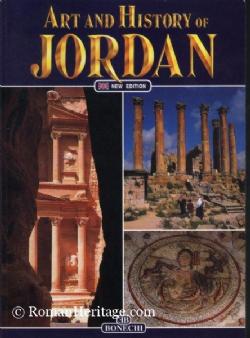RomanHeritage
is a non-profit cultural website about Ancient Rome, with Republican & Imperial Roman sites, roman ruins, Museums, books & movies, re-enactment groups, statues, Mosaics, frescoes, bronzes, etc.
Roman Heritage / Legado Romano
web sin ánimo de lucro sobre el Imperio romano, los yacimientos, ruinas romanas, museos, libros y películas, reconstrucción histórica, estatuas, mosaicos, frescos, etc.
Roman Heritage /Heredité Romaine
c'est une website sur l'empire Romain avec de Ruines romaines, museés, livres et films, groupes de reconstrucion historique, statues, mosaics et frescos.
Jordan Arabia Petrea or Arabia Felix

106 A.D. _Annexed to the Roman Empire under Trajan, by the consul Cornelius Palma, a legacy of the province of Syria.
266-272 A.D. _The Queen Zenobia declares independence and establishes her capital at Palmyra. Will be defeated and driven to Rome
635 A.D. _Conquered by Arabs
Corresponds geographically mostly with what is present-day Jordan, the south of Syria and Israel, the Sinai in Egypt and northwestern Saudi Arabia. At the time of its annexation to the Roman Empire's border with the provinces of Syria (Syria), Iudaea (Judea) and Aegiptus (Egypt) and Saudi independent line called the Limes Arabicus.Arabia Petrea is actually the former Nabataean kingdom whose capital was Petra. Despite of being on the border of the Empire, it is sufficiently protected by the desert and the nomadic tribes of Saracens invasions hampering deliveries. With the Roman conquest the capital was moved to Bostra but Petra did not lose its economic or commercial importance. Although there were temporary occupations on the border, Arabia Petrea did not suffer the constant attacks as do the other frontiers of the Empire. Moreover it was the base of a legion. La “Legio III Cyhrenaicia, that which redounded it in its major security.
The Nabataeans were an ancient Aramaic people often mentioned in the Bible. At first, laws prohibited them from planting trees, planting wheat or building houses and thereby this ensured their nomadic lifestyle. Its economy is based on the control of trade routes linking East and West. The capital, Petra, stored goods that arrived from India, the Red Sea and Arabia. These were then transported by caravans to different places and different pre-established routes. They were also good craftsmen that worked on glass, ceramic and leather and had a monopoly on luxury goods such as incense or myrrh. During the Hellenistic period they also explored architecture and sculptures.
The Nabatean kingdom thrived in its best period between the fourth century BC to the 1st century BC. From the second century BC they formed successive political alliances with the Jews of Palestine or Rome. They settled in Damascus, controlling trade routes in this area. The Romans built the Via Nova Traiana, the highway that crosses all walks past Arabia and Petra, the Nabataean capital.
With the Roman occupation, its excellent communication network and the border protected by fortifications, the Nabataeans started abandoning their nomadic life. There was an increase of the population that started to settle in cities and the Nabataeans gradually started becoming farmers. They possessed rich fields (now desertified) and large herds of sheep and cows.
Because of the continuous contact with Arab peoples, paradoxically during the pax romana, the the Nabataean people were more Arabized.
• Petra (in modern Jordan): Theatre, temples, tomb of Aretas IV ("the treasure of Pharaoh"), Roman road, several villas built as family homes with baths, atriums and toilets, decorated with sculptures, mosaics and frescoes of Pompeii style.
• Jerash (in modern Jordan): Forum portico, colonnade, Arch of Hadrian Temple of Zeus, Temple of Artemis, Nymphaeum propylaea, local museum, two theaters, gateway monuments, thermal baths.• Bosra or Bostra (Bozrah, in present Syria) black basalt Baths, theater, forum and temples.
• Palmira (Tadmir or Tadmor, in present Syria) Temples, columnata, four Tetrapylos relevantados, theater, temple of Baal, rest of pipes, local museum with good mosaics and other pieces, including a scale model of the city.






